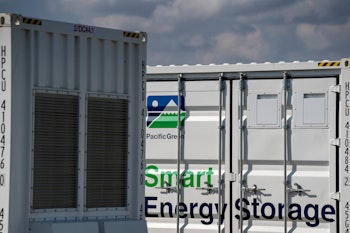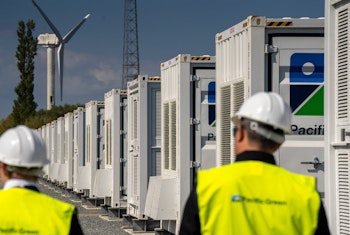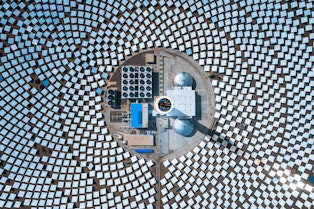It’s the year 2033. The climate is a mess, sea levels have already started to rise noticeably and the stress that global warming is inflicting on the planet is having a real impact on humanity.
But at least the energy transition is well underway and there is now a clear path to a lower-carbon, fully sustainable economy. What role does energy storage play?

From where we stand today it is impossible to guess the details, but there are some general trends that we can extrapolate from to form an idea of energy storage’s future a decade hence. The first thing to say about energy storage in 2033 is there will be a lot of it.
Almost two years ago, the analyst firm Wood Mackenzie was already predicting that global energy storage capacity—not including pumped hydro—would rise from 12.4 GW and 28 GWh in 2021 to 70 GW and 194 GWh in 2030. Today, those figures are likely to be higher.
That is because there are only two ways to decarbonise the power grid. One is to stretch transmission networks over such great distances that differences in renewable generation even out.
But the distances would need to be huge, for example running from Siberia to North Africa just to serve the European continent. Grid expansion is already a slow and costly process, so expecting continent-spanning supergrids to arise within a decade is probably wishful thinking.
That leaves the other option, which is to store renewable energy when it is available and return it to the grid when demand outstrips supply.
By 2033, storage will be a ubiquitous part of most grids around the world, helping to overcome network congestion, providing vital grid support functions and allowing clean electricity to power homes and businesses almost completely around the clock.
Most of this new energy storage capacity will be in the form of lithium-ion batteries not much different to the ones we are installing today at sites such as Richborough Energy Park in Kent, UK. Lithium-ion is a mature technology that is already manufactured at massive scale.

The scale will only grow as the global electrification of transportation progresses, with markets such as Germany and the US vying with China for manufacturing supremacy.
There is concern in some quarters over whether raw material reserves will be able to sustain such growth, but rising demand for batteries is only likely to spur new mineral discoveries and extraction—like what has happened with oil and gas.
And it is to be hoped that growing demand for battery materials will be accompanied with increased scrutiny of supply chains, to make sure mining activities are as sensitive as possible to impacts on local communities and natural habitats.
Because of this, we may see the lithium-ion battery industry favouring certain chemistries more than others.
Already, for example, there is a preference for lithium iron phosphate batteries in stationary energy storage, because they do not require cobalt—which mostly comes from the Democratic Republic of Congo, where there is little oversight of worker safety and artisanal mining is rife.
While lithium-ion will still account for the bulk of new energy storage capacity, by 2033 there will also be a host of other technologies in operation. Some of these will be familiar. China, for example, is already installing vast amounts of molten salt storage alongside concentrated solar power (CSP).
This technology can store energy at gigawatt-hour scales and by 2033 it is likely China could be getting a significant portion of its overnight electricity from CSP plants.

It remains to be seen how many other markets will follow suit, although CSP is ideal for places such as Australia, the Middle East and much of Africa and Latin America. Elsewhere, we will see innovations.
In cars, for example, lithium-ion batteries will likely have evolved into solid-state products that will be safer, lighter and more powerful than today’s technology.
Solid-state batteries are proving hard to manufacture at scale, but the technology is attracting massive investment from carmakers—so a breakthrough seems likely before this decade is out.
This is a good thing, because by 2033 it is likely that a fair chunk of energy storage capacity will also come from vehicle batteries. Vehicle-to-grid technology, which is in its infancy today, could see parked electric vehicles acting as a giant distributed battery.
The idea behind vehicle-to-grid is that if large numbers of vehicles are connected to the grid, then they can provide significant amounts of storage capacity, even if the drain on an individual car battery is miniscule.
Another novelty by 2033 will be the proliferation of a family of technologies that go under the generic name of long-duration energy storage. This refers to the ability to deliver large amounts of energy for periods of more than four to six hours.
Long-duration energy storage is a wildly diverse field, encompassing a wide array of technologies.
They include concepts such as flow batteries, where electrical charge is stored in massive vats of liquid; iron-air battery systems, which essentially store energy in rust; and gravity-based approaches, where stored power is released by dropping weights from a height.
CSP and pumped hydro both qualify as long-duration storage as well, and in fact are the only technologies in this class that can be considered commercially mature.
The diversity of other long-duration storage types could hinder their progress towards commercialisation, by making it hard for a given technology to achieve manufacturing economies of scale.
But the amount of money being funnelled into the sector, and growing moves to ensure long-duration storage is properly rewarded in power markets, means that two or three of the more novel approaches are likely to have entered the mainstream 10 years from now.
Finally, by 2033 it is likely that low-carbon hydrogen will be replacing fossil fuels in a range of roles—including, perhaps, acting as a medium for energy storage on a scale of days to weeks.
As a company that has always prided itself on technology innovation, at Pacific Green we are excited to see the evolution of this market—and the new business opportunities it could yield.
Publish date: 16 October, 2023